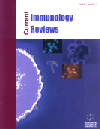- Home
- A-Z Publications
- Current Immunology Reviews (Discontinued)
- Previous Issues
- Volume 8, Issue 4, 2012
Current Immunology Reviews (Discontinued) - Volume 8, Issue 4, 2012
Volume 8, Issue 4, 2012
-
-
Polyglandular Autoimmune Syndromes
More LessAuthors: Khaled El Baba, Mira Zantout and Sami T. AzarPolyglandular Autoimmune Syndromes (PAS) form different clusters of autoimmune disorders characterized by the coexistence of at least two glandular autoimmune mediated diseases [1]. They are generally classified into three types: a very rare juvenile type 1(PAS I) and a relatively common adult type with (PAS II) or without adrenal failure (PAS III) [2, 3]. PAS I, also known as autoimmune polyendocrinopathy-candidia Read More
-
-
-
Autoimmune Hepatitis: Pathophysiology, Diagnosis and Pharmacological Therapy
More LessAutoimmune hepatitis (AIH) is a chronic inflammatory liver disease, rare and of unknown etiology, that affects patients who lack tolerance to self antigens. Genetic and environmental factors are related to the disease etiology. The pathology, mainly prevalent in females, is characterized by the presence of interface hepatitis with biochemical changes, such as increased levels of transaminase, the presence of hypergammaglobul Read More
-
-
-
A Surgical Opinion on Hyperalgesia/Nociception, Inflammatory/Neurogenic Pain and Anti-inflammatory Responses and Drug Interventions Revisited: Current Breakthroughs and Views
More LessAll sensory modalities are essentially important, but pain serves a protective function and is indispensable for survival, and, technically, pain is considered one of the most common symptoms of injuries and related diseases. Inflammatory cells and inflammatory mediators are crucially involved in the propensity, genesis, persistence and severity of pain, commonly known as nociception or hyperalgesia, following trauma, Read More
-
-
-
NKT Cell Subsets Can Exert Opposing Effects in Autoimmunity, Tumor Surveillance and Inflammation
More LessAuthors: Rachael Viale, Randle Ware, Igor Maricic, Varun Chaturvedi and Vipin KumarThe innate-like natural killer T (NKT) cells are essential regulators of immunity. These cells comprise at least two distinct subsets and recognize different lipid antigens presented by the MHC class I like molecules CD1d. The CD1ddependent recognition pathway of NKT cells is highly conserved from mouse to humans. While most type I NKT cells can recognize αGalCer and express a semi-invariant T cell receptor (TCR), a major p Read More
-
-
-
Autoimmune Diseases and Atherosclerosis: The Inflammatory Connection
More LessAuthors: Meenakshi Varma, Lakshmi A. Mundkur and V.V. KakkarAtherosclerosis is a chronic inflammatory disease that contributes to majority of cardiovascular morbidity and mortality in the world. Immune system is involved in atherogenesis and disease pathogenesis. Several studies have suggested a pivotal role for immune response to autoantigens, particularly oxidized lipoproteins and heat shock proteins, in the development of the disease. Several autoimmune disorders such as infl Read More
-
-
-
MICA Molecules in Disease and Transplantation, a Double-Edged Sword?
More LessMajor histocompatibility complex class I chain-related member A (MICA) encodes a stress-induced cellsurface glycoprotein that is expressed in keratinocytes, fibroblasts and gastrointestinal epithelium, among others. MICA is not associated with β2-microglobulin and does not appear to present peptides. MICA displays a high degree of allele polymorphism within the non-classical HLA gene loci. The functional significance Read More
-
Volumes & issues
Most Read This Month
Article
content/journals/cir
Journal
10
5
false
en


